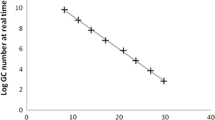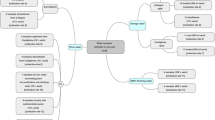Abstract
This study investigated the influence of viral interference on the detection of enteric viruses using the integrated cell culture (ICC)-PCR with a BGM cell line. It was possible to detect 102 plaque-forming units (PFU)/flask of enterovirus 71 (EV71) in spite of the presence of 104 PFU/flask of adenovirus 40 (AdV40). Meanwhile, 104 PFU/flask of AdV40 was not detected in the presence of 102 PFU/flask of EV71. This inhibition of AdV40 detection using ICC-PCR was attributable to the growth of EV71, because the addition of a growth inhibitor of EV71 (rupintrivir) neutralized the detection inhibition of AdV40. The growth inhibition of AdV40 under co-infection with EV71 is probably caused by the immune responses of EV71-infected cells. AdV is frequently used as a fecal contamination indicator of environmental water, but this study demonstrated that false-negative detection of infectious AdV using ICC-PCR could be caused by the co-existence of infectious EV in a water sample. The addition of rupintrivir could prevent false-negative detection of AdV using ICC-PCR. This study, therefore, emphasizes the importance of confirming the presence of multiple enteric viruses in a sample derived from environmental water prior to the application of ICC-PCR because the viral interference phenomenon may lead to the false-negative detection of target viruses.





Similar content being viewed by others
References
Albinana-Gimenez, N., Miagostovich, M. P., Calgua, B., Huguet, J. M., Matia, L., & Girones, R. (2009). Analysis of adenoviruses and polyomaviruses quantified by qPCR as indicators of water quality in source and drinking-water treatment plants. Water Research, 43(7), 2011–2019. https://doi.org/10.1016/j.watres.2009.01.025.
Alidjinou, E. K., Sane, F., Lefevre, C., Baras, A., Moumna, I., Engelmann, I., et al. (2017). Enteroviruses in blood of patients with type 1 diabetes detected by integrated cell culture and reverse transcription quantitative real-time PCR. Acta Diabetologica, 54(11), 1025–1029. https://doi.org/10.1007/s00592-017-1041-7.
Amarasiri, M., Kitajima, M., Miyamura, A., Santos, R., Monteiro, S., Miura, T., et al. (2018). Reverse transcription-quantitative PCR assays for genotype-specific detection of human noroviruses in clinical and environmental samples. International Journal of Hygiene and Environmental Health, 221(3), 578–585. https://doi.org/10.1016/j.ijheh.2018.02.008.
Aouini, R., Laamiri, N., & Ghram, A. (2018). Viral interference between low pathogenic avian influenza H9N2 and avian infectious bronchitis viruses in vitro and in ovo. Journal of Virological Methods, 259(March), 92–99. https://doi.org/10.1016/j.jviromet.2018.06.011.
Arita, M., Kojima, H., Nagano, T., Okabe, T., Wakita, T., & Shimizu, H. (2011). Phosphatidylinositol 4-kinase III beta is a target of enviroxime-like compounds for antipoliovirus activity. Journal of Virology, 85(5), 2364–2372. https://doi.org/10.1128/jvi.02249-10.
Bailey, E. S., Casanova, L. M., Simmons, O. D., & Sobsey, M. D. (2018). Tertiary treatment and dual disinfection to improve microbial quality of reclaimed water for potable and non-potable reuse: A case study of facilities in North Carolina. Science of the Total Environment, 630, 379–388. https://doi.org/10.1016/j.scitotenv.2018.02.239.
Bigliardi, L., & Sansebastiano, G. (2006). Study on inactivation kinetics of hepatitis A virus and enteroviruses with peracetic acid and chlorine. New ICC/PCR method to assess disinfection effectiveness. Journal of Preventive Medicine and Hygiene, 47(2), 56–63.
Blackmer, F., Reynolds, K. A., Gerba, C. P., & Pepper, I. L. (2000). Use of integrated cell culture-PCR to evaluate the effectiveness of poliovirus inactivation by chlorine. Applied and Environmental Microbiology, 66(5), 2267–2268. https://doi.org/10.1128/AEM.66.5.2267-2268.2000.
Bofill-Mas, S., Albinana-Gimenez, N., Clemente-Casares, P., Hundesa, A., Rodriguez-Manzano, J., Allard, A., et al. (2006). Quantification and stability of human adenoviruses and polyomavirus JCPyV in wastewater matrices. Applied and Environmental Microbiology, 72(12), 7894–7896. https://doi.org/10.1128/AEM.00965-06.
Canh, V. D., Kasuga, I., Furumai, H., & Katayama, H. (2018). Impact of various humic acids on EMA-RT-qPCR to selectively detect intact viruses in drinking water. Journal of Water and Environment Technology, 16(2), 83–93. https://doi.org/10.2965/jwet.17-044.
Chapron, C. D., Ballester, N. A., Fontaine, J. H., Frades, C. N., & Margolin, A. B. (2000). Detection of astroviruses, enteroviruses, and adenovirus types 40 and 41 in surface waters collected and evaluated by the information collection rule and an integrated cell culture-nested PCR procedure. Applied and Environmental Microbiology, 66(6), 2520–2525. https://doi.org/10.1128/AEM.66.6.2520-2525.2000.
de Souza, F. G., da Silva, F. P., Staggemeier, R., Rigotto, C., & Spilki, F. R. (2018). Low occurrence of hepatitis a virus in water samples from an urban area of southern Brazil. Revista do Instituto de Medicina Tropical de São Paulo, 60, e69. https://doi.org/10.1590/s1678-9946201860069.
Elmahdy, E. M., Ahmed, N. I., Shaheen, M. N. F., Mohamed, E. C. B., & Loutfy, S. A. (2019). Molecular detection of human adenovirus in urban wastewater in Egypt and among children suffering from acute gastroenteritis. Journal of Water and Health, 17(2), 287–294. https://doi.org/10.2166/wh.2019.303.
Farkas, K., Marshall, M., Cooper, D., McDonald, J. E., Malham, S. K., Peters, D. E., et al. (2018). Seasonal and diurnal surveillance of treated and untreated wastewater for human enteric viruses. Environmental Science and Pollution Research, 25(33), 33391–33401. https://doi.org/10.1007/s11356-018-3261-y.
Gale, M. (2015). Interference with virus infection. The Journal of Immunology, 195(5), 1909–1910. https://doi.org/10.4049/jimmunol.1501575.
Greening, G. E., Hewitt, J., & Lewis, G. D. (2002). Evaluation of integrated cell culture-PCR (C-PCR) for virological analysis of environmental samples. Journal of Applied Microbiology, 93(5), 745–750. https://doi.org/10.1046/j.1365-2672.2002.01741.x.
Haramoto, E., Kitajima, M., Hata, A., Torrey, J. R., Masago, Y., Sano, D., & Katayama, H. (2018). A review on recent progress in the detection methods and prevalence of human enteric viruses in water. Water Research, 135, 168–186. https://doi.org/10.1016/j.watres.2018.02.004.
He, J.-W., & Jiang, S. (2005). Quantification of enterococci and human adenoviruses in environmental samples by real-time PCR. Applied and Environmental Microbiology, 71(5), 2250–2255. https://doi.org/10.1128/AEM.71.5.2250-2255.2005.
Hewitt, J., Greening, G. E., Leonard, M., & Lewis, G. D. (2013). Evaluation of human adenovirus and human polyomavirus as indicators of human sewage contamination in the aquatic environment. Water Research, 47(17), 6750–6761. https://doi.org/10.1016/j.watres.2013.09.001.
Horga, M. A., Gusella, G. L., Greengard, O., Poltoratskaia, N., Porotto, M., & Moscona, A. (2000). Mechanism of interference mediated by human parainfluenza virus type 3 infection. Journal of Virology, 74(24), 11792–11799. https://doi.org/10.1128/JVI.74.24.11792-11799.2000.
Jiang, Y.-J., Liao, G.-Y., Zhao, W., Sun, M.-B., Qian, Y., Bian, C.-X., & Jiang, S.-D. (2004). Detection of infectious hepatitis A virus by integrated cell culture/strand-specific reverse transcriptase-polymerase chain reaction. Journal of Applied Microbiology, 97(5), 1105–1112. https://doi.org/10.1111/j.1365-2672.2004.02413.x.
Jothikumar, N., Cromeans, T. L., Hill, V. R., Lu, X., Sobsey, M. D., & Erdman, D. D. (2005). Quantitative real-time PCR assays for detection of human adenoviruses and identification of serotypes 40 and 41. Applied and Environmental Microbiology, 71(6), 3131–3136. https://doi.org/10.1128/AEM.71.6.3131-3136.2005.
Katayama, H., Haramoto, E., Oguma, K., Yamashita, H., Tajima, A., Nakajima, H., & Ohgaki, S. (2008). One-year monthly quantitative survey of noroviruses, enteroviruses, and adenoviruses in wastewater collected from six plants in Japan. Water Research, 42(6–7), 1441–1448. https://doi.org/10.1016/j.watres.2007.10.029.
Kitajima, M., Iker, B. C., Pepper, I. L., & Gerba, C. P. (2014). Relative abundance and treatment reduction of viruses during wastewater treatment processes-identification of potential viral indicators. The Science of the Total Environment, 488–489, 290–296. https://doi.org/10.1016/j.scitotenv.2014.04.087.
Kitano, M., Hosmillo, M., Emmott, E., Lu, J., & Goodfellow, I. (2018). Selection and characterization of rupintrivir-resistant Norwalk virus replicon cells in vitro. Antimicrobial Agents and Chemotherapy, 62(5), e00201-18. https://doi.org/10.1128/AAC.00201-18.
Ko, G., Cromeans, T. L., & Sobsey, M. D. (2005). UV inactivation of adenovirus type 41 measured by cell culture mRNA RT-PCR. Water Research, 39(15), 3643–3649. https://doi.org/10.1016/j.watres.2005.06.013.
Kuo, D. H.-W., Simmons, F. J., Blair, S., Hart, E., Rose, J. B., & Xagoraraki, I. (2010). Assessment of human adenovirus removal in a full-scale membrane bioreactor treating municipal wastewater. Water Research, 44(5), 1520–1530. https://doi.org/10.1016/j.watres.2009.10.039.
Lambertini, E., Spencer, S. K., Bertz, P. D., Loge, F. J., Kieke, B. A., & Borchardt, M. A. (2008). Concentration of enteroviruses, adenoviruses, and noroviruses from drinking water by use of glass wool filters. Applied and Environmental Microbiology, 74(10), 2990–2996. https://doi.org/10.1128/AEM.02246-07.
Lee, H. K., & Jeong, Y. S. (2004). Comparison of total culturable virus assay and multiplex integrated cell culture-PCR for reliability of waterborne virus detection. Applied and Environmental Microbiology, 70(6), 3632–3636. https://doi.org/10.1128/AEM.70.6.3632-3636.2004.
Lee, S.-H., Lee, C., Lee, K. W., Cho, H. B., & Kim, S.-J. (2005). The simultaneous detection of both enteroviruses and adenoviruses in environmental water samples including tap water with an integrated cell culture-multiplex-nested PCR procedure. Journal of Applied Microbiology, 98(5), 1020–1029. https://doi.org/10.1111/j.1365-2672.2004.02496.x.
Li, D., Gu, A. Z., He, M., Shi, H. C., & Yang, W. (2009). UV inactivation and resistance of rotavirus evaluated by integrated cell culture and real-time RT-PCR assay. Water Research, 43(13), 3261–3269. https://doi.org/10.1016/j.watres.2009.03.044.
Majumdar, M., Sharif, S., Klapsa, D., Wilton, T., Masroor Alam, M., Fernandez-Garcia, M. D., et al. (2018). Environmental surveillance reveals complex enterovirus circulation patterns in human populations. Open Forum Infectious Diseases, 5(10), 1–9. https://doi.org/10.1093/ofid/ofy250.
Marie, V., & Lin, J. (2017). Viruses in the environment—Presence and diversity of bacteriophage and enteric virus populations in the Umhlangane River, Durban, South Africa. Journal of Water and Health, 15(6), 966–981. https://doi.org/10.2166/wh.2017.066.
Monpoeho, S., Dehée, A., Mignotte, B., Schwartzbrod, L., Marechal, V., Nicolas, J.-C., et al. (2000). Quantification of Enterovirus RNA in sludge samples using single tube real-time RT-PCR. BioTechniques, 29(1), 88–93. https://doi.org/10.2144/00291st03.
Pina, S., Puig, M., Lucena, F., Jofre, J., & Girones, R. (1998). Viral pollution in the environment and in shellfish: Human adenovirus detection by PCR as an index of human viruses. Applied and Environmental Microbiology, 64(9), 3376–3382.
Reynolds, K. A., Gerba, C. P., & Pepper, I. L. (1996). Detection of infectious enteroviruses by an integrated cell culture-PCR procedure. Applied and Environmental Microbiology, 62(4), 1424–1427.
Rigotto, C., Sincero, T. C. M., Simões, C. M. O., & Barardi, C. R. M. (2005). Detection of adenoviruses in shellfish by means of conventional-PCR, nested-PCR, and integrated cell culture PCR (ICC/PCR). Water Research, 39(2–3), 297–304. https://doi.org/10.1016/j.watres.2004.10.005.
Ryu, H., Schrantz, K. A., Brinkman, N. E., & Boczek, L. A. (2018). Applicability of integrated cell culture reverse transcriptase quantitative PCR (ICC-RTqPCR) for the simultaneous detection of the four human enteric enterovirus species in disinfection studies. Journal of Virological Methods, 258(May), 35–40. https://doi.org/10.1016/j.jviromet.2018.05.008.
Salas-Benito, J. S., & De Nova-Ocampo, M. (2015). Viral interference and persistence in mosquito-borne flaviviruses. Journal of Immunology Research, 2015(November), 873404. https://doi.org/10.1155/2015/873404.
Schultz-Cherry, S. (2015). Viral interference: The case of influenza viruses. Journal of Infectious Diseases, 212(10), 1690–1691. https://doi.org/10.1093/infdis/jiv261.
Syverton, J. T., & Berry, G. P. (1947). Multiple virus infection of single host cells. The Journal of Experimental Medicine, 86(2), 145–152. https://doi.org/10.1084/jem.86.2.145.
Valverde, E. J., Borrego, J. J., & Castro, D. (2016). Evaluation of an integrated cell culture RT-PCR assay to detect and quantify infectious lymphocystis disease virus. Journal of Virological Methods, 238, 62–65. https://doi.org/10.1016/j.jviromet.2016.09.016.
Wagner, R. R. (1960). Viral interference: Some considerations of basic mechanisms and their potential relationship to host resistance. Microbiology and Molecular Biology Reviews, 24(1), 151–166.
Zhang, X., Song, Z., Qin, B., Zhang, X., Chen, L., Hu, Y., & Yuan, Z. (2013). Rupintrivir is a promising candidate for treating severe cases of enterovirus-71 infection: Evaluation of antiviral efficacy in a murine infection model. Antiviral Research, 97(3), 264–269. https://doi.org/10.1016/j.antiviral.2012.12.029.
Acknowledgements
We thank Dr. Hiroyuki Shimizu and Dr. Minetaro Arita, National Institute of Infectious Diseases, Japan for providing viral strains and suggestions on growth inhibitors used in this study.
Funding
This study was funded by Japan Society for the Promotion of Science KAKENHI 16 K12635 (Grant-in-Aid for Challenging Exploratory Research).
Author information
Authors and Affiliations
Contributions
Conceptualization, D.S., M.K., and S.O.; methodology, D.S. and R.W.; formal analysis, W.O.; investigation, R.W. and W.O.; resources, D.S.; data curation, R.W. and W.O.; writing—original draft preparation, D.S.; writing—review and editing, D.S., M.K., M.A., and S.O.; visualization, D.S.; supervision, D.S.; project administration, D.S.; funding acquisition, D.S.”
Corresponding author
Ethics declarations
Conflict of Interest
The authors declare no conflict of interest.
Additional information
Publisher’s Note
Springer Nature remains neutral with regard to jurisdictional claims in published maps and institutional affiliations.
Rights and permissions
About this article
Cite this article
Sano, D., Watanabe, R., Oishi, W. et al. Viral Interference as a Factor of False-Negative in the Infectious Adenovirus Detection Using Integrated Cell Culture-PCR with a BGM Cell Line. Food Environ Virol 13, 84–92 (2021). https://doi.org/10.1007/s12560-020-09453-x
Received:
Accepted:
Published:
Issue Date:
DOI: https://doi.org/10.1007/s12560-020-09453-x




